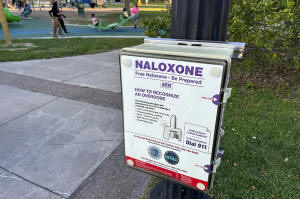The fate of addiction treatment hangs in the balance with Kennedy's HHS
overhaul
[March 28, 2025]
By CARLA K. JOHNSON
A little-known federal agency that touches the lives of people across
the United States by funding the 988 crisis line, naloxone distribution
and addiction treatment may be weakened and possibly eliminated in the
proposed overhaul of the U.S. Department of Health and Human Services.
In Health Secretary Robert F. Kennedy Jr. 's plan, the $8 billion
Substance Abuse and Mental Health Services Administration, or SAMHSA,
would be absorbed into a new office, where its more than 700 staffers
would co-exist with employees from other agencies responsible for
chemical exposures and work-related injuries. In all, five agencies are
to be swallowed up under what will be called the Administration for a
Healthy America, or AHA, echoing Kennedy’s Make America Healthy Again
slogan.
Merging SAMHSA into a larger agency “will increase operational
efficiency and assure programs are carried out because it will break
down artificial divisions between similar programs," according to an HHS
news release.
“Millions of Americans who get mental health and substance use services
depend on SAMHSA even if they have never heard the name of the agency,”
said Brendan Saloner, an addiction researcher at Johns Hopkins Bloomberg
School of Public Health.
During Kennedy's confirmation hearings, he said he was addicted to
heroin for 14 years and has been in recovery for 42 years. He called
medication-assisted treatment such as Suboxone (buprenorphine) and
methadone medically necessary — but also said he considers the gold
standard to be 12-step programs like Alcoholics Anonymous and Narcotics
Anonymous. During his presidential campaign, Kennedy had proposed a
network of “healing farms” where people could work while recovering from
addiction.

SAMHSA was created by Congress in 1992, so closing it is illegal and
raises questions about Kennedy’s commitment to treating addiction and
mental health, said Keith Humphreys, a Stanford University addiction
researcher.
“Burying the agency in an administrative blob with no clear purpose is
not the way to highlight the problem or coordinate a response,”
Humphreys said.
[to top of second column]
|

A box containing free doses of naloxone, a nasal spray medication to
reverse drug overdoses, is installed at Ontario Beach Park in
Rochester, N.Y., on Monday, Sept. 2, 2024. (AP Photo/Ted Shaffrey,
File)
 Other experts said crippling SAMSHA
could stall progress on overdose deaths. The agency regulates
methadone clinics and pays for addiction prevention efforts in all
50 states.
“There’s a reason why we have reduced overdose in this country, it’s
because SAMHSA has been doing its job so well,” said Dr. Ruth Potee,
medical director for seven methadone clinics in Massachusetts. “My
jaw drops at this news.”
Noting the 24% decline in drug overdose deaths over a recent
12-month period, former White House drug czar Dr. Rahul Gupta said
he's concerned the bureaucratic overhaul will slow momentum.
“A worsening overdose crisis is the last thing our nation needs,”
said Gupta, who served under President Joe Biden.
The announcement follows weeks of dismissals and grant terminations
that have created an atmosphere of shock and fear among
government-funded researchers and federal health employees.
Saloner said overhauling a large organization could be done in a way
that leads to better services for people, “but I am troubled by the
lack of a deliberative process that seems to be creating chaos and
driving really talented people out of the federal workforce.”
___
The Associated Press Health and Science Department receives support
from the Howard Hughes Medical Institute’s Science and Educational
Media Group and the Robert Wood Johnson Foundation. The AP is solely
responsible for all content.
All contents © copyright 2025 Associated Press. All rights reserved |